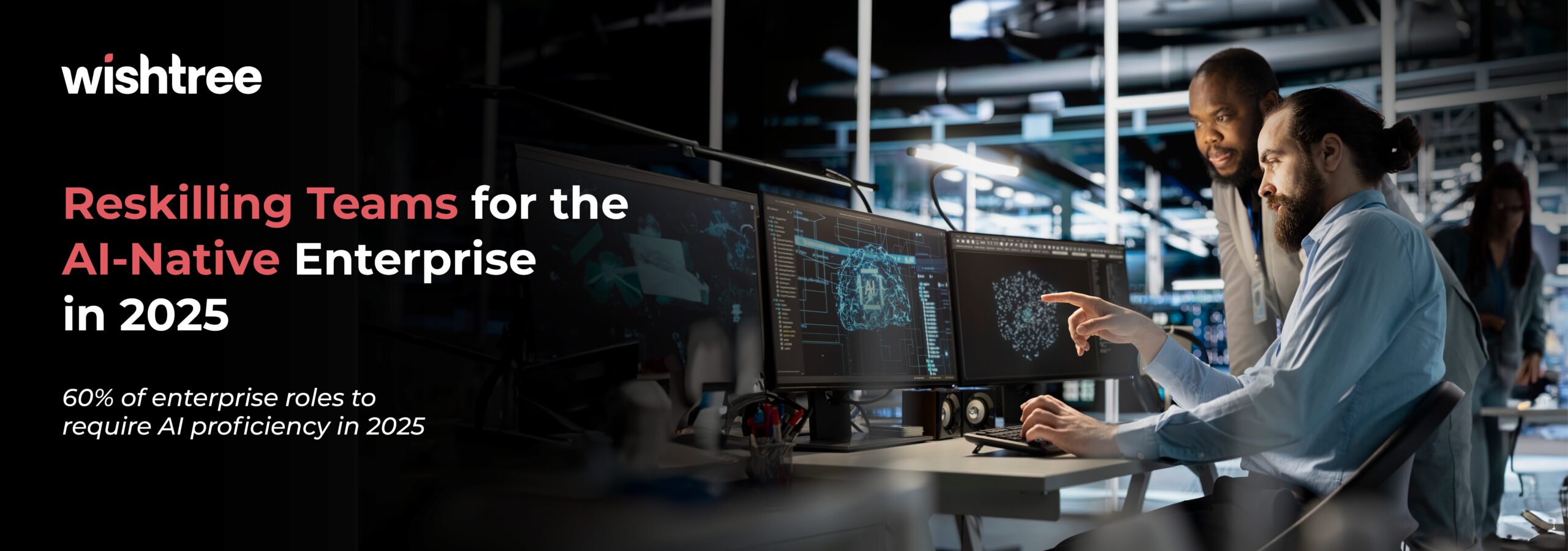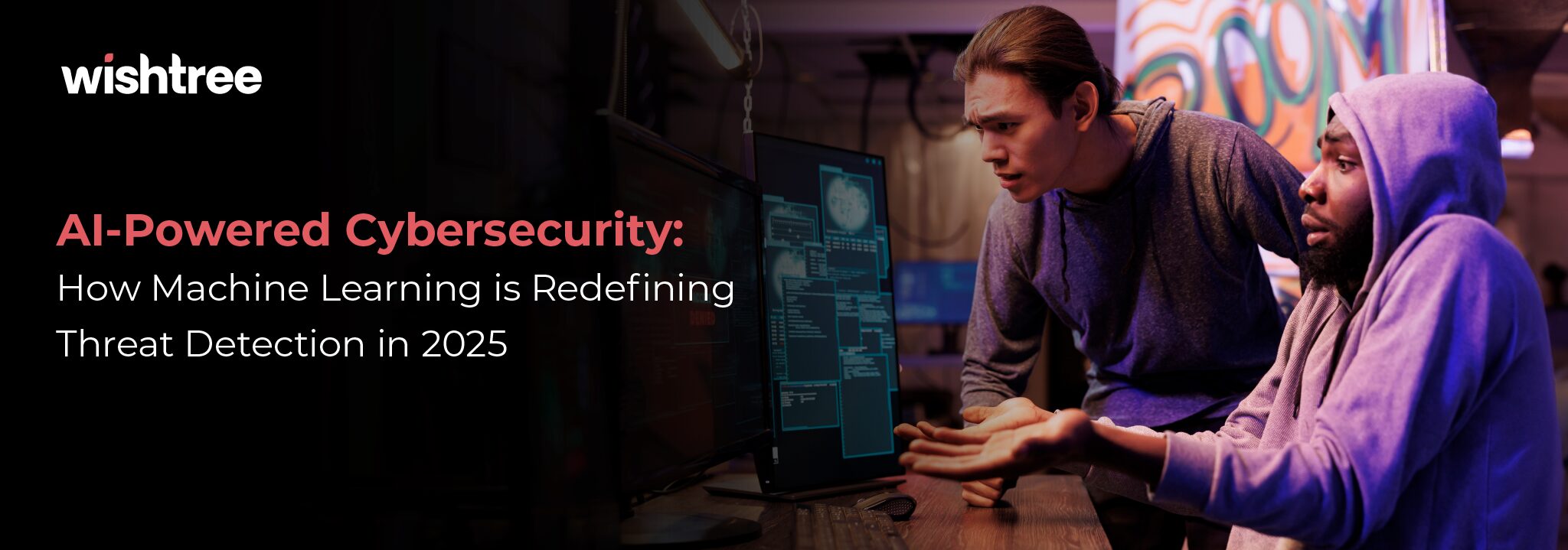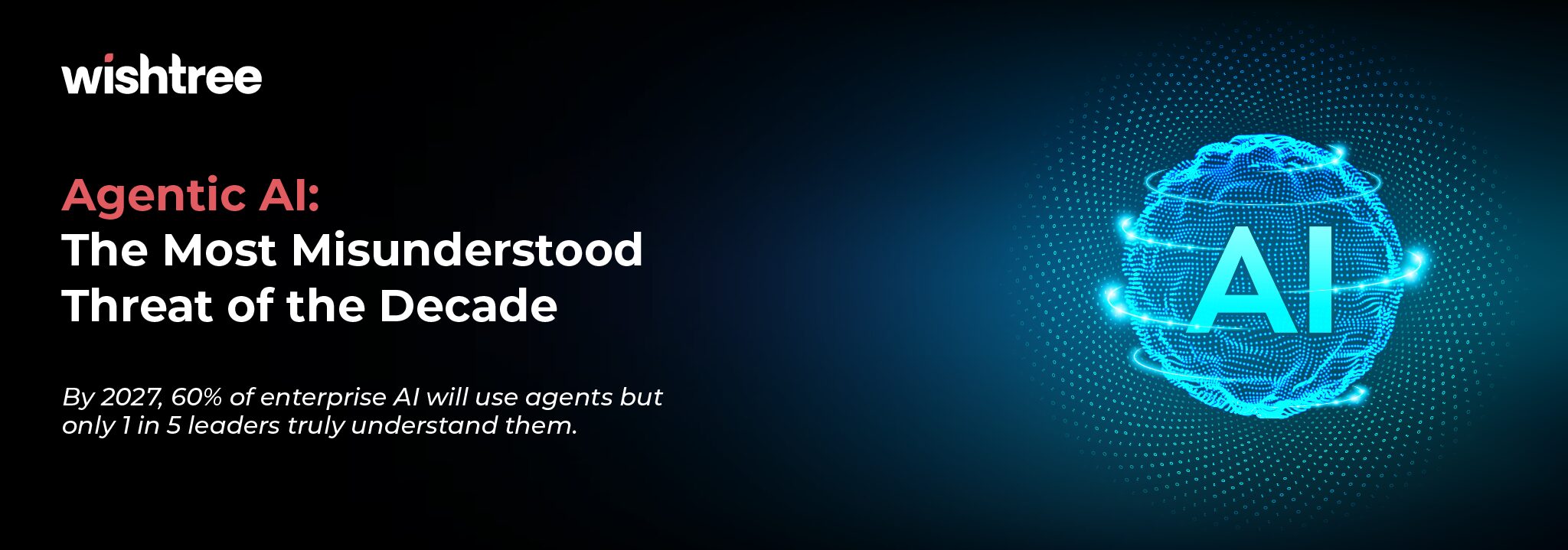Table of Contents
Introduction
The landscape of work is undergoing an unprecedented transformation, with Artificial Intelligence at its core.
Gartner predicts that by 2025, a staggering 60% of all enterprise roles will necessitate proficiency in collaborating with AI, yet a concerning reality looms: only 30% of the current global workforce is adequately prepared for this shift. This isn’t merely a challenge; it’s the defining talent crisis of our time.
The critical question for every forward-thinking organization isn’t if your team needs reskilling, but how to execute this crucial transformation effectively and efficiently, without disrupting your ongoing operations.
At Wishtree Technologies, we understand that building an AI-native enterprise requires more than just cutting-edge technology; it demands a workforce capable of harnessing its full potential. This comprehensive guide will equip you with the insights and strategies needed to navigate the evolving demands of the AI era.
Join us as we explore the essential steps to empower your workforce, bridge the AI skills gap, and ensure your enterprise thrives in the AI-first economy.
The 2025 AI Skills Matrix: What Your Team Needs
The rapid evolution of AI demands a dynamic shift in skillsets across all roles. The traditional boundaries between “tech” and “non-tech” are blurring, giving way to a universal need for AI fluency.
Technical Roles
For your core technical talent, the focus has moved beyond basic AI interaction to more complex, autonomous AI management.
Skill | 2024 Focus | 2025 Evolution | Tools to Learn |
| Prompt Engineering | ChatGPT best practices | Agent Orchestration (AutoGen, CrewAI) | GPT-5, Claude 4, Mistral 12B, Llama 4, custom SLMs |
| AI-Augmented Coding | Copilot assistance | Full-stack AI development (AI writes 70% of code) | GitHub Copilot X, Amazon CodeWhisperer 2, Google Gemini Code Assistant |
| Responsible AI | Bias detection | Quantum-safe AI governance, explainable AI | IBM watsonx.governance, AWS AI Service Cards, Microsoft Azure Machine Learning Studio |
Non-Technical Roles
The integration of AI isn’t limited to engineering teams. Every department needs to understand how to leverage AI tools for efficiency and strategic advantage.
- Sales/Marketing: Mastery of generative BI tools (e.g., effortlessly turning a natural language query like “Show me Q3 trends for new customer acquisition in the APAC region” into interactive dashboards and insightful reports).
- HR: Proficiency in AI-powered talent matching and skills graph analysis using platforms like Eightfold AI, to identify internal skill gaps, optimize recruitment, and personalize career development paths.
- Operations: Expertise in process mining with AI agents (e.g., using Celonis integrated with Microsoft Process Advisor) to identify bottlenecks, automate workflows, and optimize operational efficiency.
Wishtree Insight:
In 2025, the divide isn’t ‘tech vs. non-tech’ – it’s ‘augmented vs. obsolete’. Even CFOs now routinely use sophisticated AI agents for real-time financial forecasting, scenario planning, and risk analysis, transforming traditional roles into strategic AI collaborators.
Wishtree’s AI Reskilling Framework
- Skills Radar: An AI-powered assessment tool that conducts a granular analysis of your team’s current AI competencies, identifying critical skill gaps and emerging needs relative to your business objectives.
- Micro-Certifications: Development and delivery of bite-sized, highly focused courses designed for immediate applicability and measurable skill acquisition.
- AI Apprenticeships: A unique program where employees shadow company-specific AI agents and autonomous systems, learning how to monitor, debug, and optimize their performance in real-time operational environments.
The 2025 Playbook: Building Your Reskilling Program
Transforming your workforce for the AI-native enterprise requires a structured, strategic approach.
Step 1: Map AI’s Role in Each Job
Before you can reskill, you must clearly define how AI will augment or transform every role within your organization.
- Example: A supply chain manager in 2025 no longer just manages logistics; their role is heavily augmented by AI.
- Critical Skill: Debugging and optimizing autonomous inventory agents, which manage stock levels and order placements.
- Key Tool: SAP’s AI Copilot integrated with fine-tuned LLMs for predictive demand forecasting and intelligent route optimization.
Step 2: Choose Your Training Model
The right training approach depends on your organization’s size, culture, and specific needs.
Model | Best For | Pros | Cons |
| In-House Academies (e.g., PwC’s AI Campus) | Large enterprises with diverse needs | Provides highly tailored content specific to organizational goals and internal systems; fosters a strong internal learning culture and knowledge sharing. | High upfront cost for content development and infrastructure; requires significant internal resources to manage and maintain. |
| AI-Powered Learning Platforms (e.g., Coursera’s 2025 AI Coach, Udemy Business) | Distributed teams, continuous learning | Offers adaptive learning paths personalized to individual skill levels and career goals; provides access to a vast library of constantly updated courses and certifications from industry experts. | Less customization for hyper-specific internal tools or proprietary processes; engagement can vary without direct mentorship. |
| Partner-Led Bootcamps (e.g., Wishtree’s AI Reskilling Sprints) | Fast transformation, targeted skill acquisition | Delivers intensive, focused training with real-world use cases and hands-on projects; benefits from external expertise and rapid curriculum updates; often provides immediate, measurable ROI. | Requires strong organizational buy-in for employee participation; may not cover every niche internal system without specific customization. |
Step 3: Measure ROI
Without clear metrics, your reskilling efforts are just an expense. Tangible ROI ensures sustained investment and demonstrates value. Track metrics like:
- AI Adoption Rate: The percentage of employees actively using AI tools in their weekly workflows, demonstrating effective integration.
- Process Speed: Quantifiable time saved per task (e.g., the reduction in time for contract review, report generation, or data analysis) due to AI augmentation.
- Innovation Yield: The number of AI-generated ideas, solutions, or products that are successfully implemented within the organization, showcasing AI’s contribution to innovation.
- Employee Engagement & Retention: Tracking improved job satisfaction and reduced turnover among employees who feel empowered by new AI skills.
The Future of Work: 2026 Predictions
The rapid evolution of AI promises even more profound shifts in the very nature of work by 2026.
- AI Teammates Get Promoted: Autonomous AI agents will not only perform tasks but will also be subject to “performance reviews” based on their efficiency, accuracy, and impact, potentially even gaining delegated budget authority for specific operational areas.
- Skills Graphs Replace Resumes: Platforms like LinkedIn will automatically update user profiles based on AI-certified competencies and real-time skill acquisition data from learning platforms, making traditional static resumes largely obsolete.
- The Rise of the Chief AI Officer (CAIO): IDC predicts that 45% of Fortune 500 companies will have a dedicated Chief AI Officer (CAIO) by 2026, signaling the strategic imperative of AI leadership at the executive level. This role will oversee AI strategy, governance, ethics, and talent development.
Conclusion: Start Small, Scale Fast
The AI talent gap is a critical challenge that won’t close itself. Proactive investment in reskilling your workforce is not just a strategic advantage, it’s an imperative for survival and growth. Companies that act decisively now to empower their teams with AI fluency will be the ones that dominate their industries by 2026.
At Wishtree Technologies, we are committed to helping you navigate this transformation. Don’t let your talent strategy become an obstacle to your AI ambitions.
Contact us today to assess your organization’s unique challenges and opportunities in the AI-native landscape!



